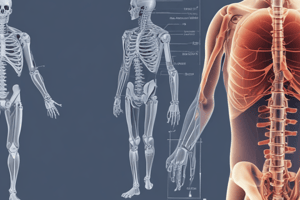Podcast
Questions and Answers
What is a key limitation of X-ray imaging due to tissue density differences?
What is a key limitation of X-ray imaging due to tissue density differences?
- High distortion levels
- Inability to identify fractures
- No use in identifying tumors
- Poor resolution (correct)
How does MRI scanning technology differ from mammography in terms of radiation exposure?
How does MRI scanning technology differ from mammography in terms of radiation exposure?
- MRI scanning involves radiation exposure.
- Both MRI and mammography utilize radiation.
- MRI scanning does not involve radiation exposure. (correct)
- Mammography is noninvasive, unlike MRI scanning.
Which diagnostic tool allows for multiplanar imaging without radiation exposure or invasive procedures?
Which diagnostic tool allows for multiplanar imaging without radiation exposure or invasive procedures?
- CT scans
- MRI scans (correct)
- Ultrasound imaging
- X-ray imaging
What is a common use of X-ray imaging in medical diagnosis?
What is a common use of X-ray imaging in medical diagnosis?
Which technique utilizes powerful magnets and radio waves to create high-resolution images without radiation?
Which technique utilizes powerful magnets and radio waves to create high-resolution images without radiation?
What makes CT scans more effective in detecting subtle signs of injury or infection compared to conventional radiography?
What makes CT scans more effective in detecting subtle signs of injury or infection compared to conventional radiography?
Which imaging modality does NOT expose patients to ionizing radiation?
Which imaging modality does NOT expose patients to ionizing radiation?
What is the key advantage of Ultrasound imaging over CT scans and X-ray imaging?
What is the key advantage of Ultrasound imaging over CT scans and X-ray imaging?
How do CT scans reconstruct the complex, three-dimensional structure of organs and tissues within the body?
How do CT scans reconstruct the complex, three-dimensional structure of organs and tissues within the body?
In terms of radiation exposure, how does MRI differ from CT scans?
In terms of radiation exposure, how does MRI differ from CT scans?
Flashcards are hidden until you start studying
Study Notes
Radiology: Diagnostic Physics with X-Ray Imaging, MRI Scans, CT Scans, and Ultrasound Imaging
Radiology is a medical specialty that involves using various forms of ionizing radiation and other imaging techniques to diagnose and treat diseases and injuries within the body. This field encompasses several key diagnostic tools including X-rays, magnetic resonance imaging (MRI) scans, computed tomography (CT) scans, and ultrasound imaging. Each technique has its own strengths and limitations, allowing radiologists to gather valuable information for accurate diagnosis and treatment planning.
X-Ray Imaging
X-ray imaging uses electromagnetic radiation to produce a visual representation of the internal structures of the human body. This technique is particularly useful in identifying fractures, tumors, and foreign objects like bullets or shrapnel. However, it has limitations such as poor resolution and distortion due to tissue density differences, resulting in images that may require interpretation by a trained professional.
Magnetic Resonance Imaging (MRI) Scans
MRI scanning technology is noninvasive, meaning it does not involve radiation like mammography or X-rays. Instead, it employs powerful magnets to align atomic nuclei and radio waves to create high-resolution images. It provides excellent soft tissue contrast and allows for multiplanar imaging without radiation exposure or insertion of needles or catheters.
Computed Tomography (CT) Scans
Computed tomography (CT) is another type of medical imaging technique that combines multiple x-ray views into cross-sectional images of the body. By rotating the patient around, these systems can capture image data from different angles and reconstruct the complex, three-dimensional structure of organs and tissues within the body. CT scans can detect more subtle signs of injury or infection compared to conventional radiography due to their ability to obtain detailed information about the internal structures and functioning of the body.
Ultrasound Imaging
Ultrasound imaging uses sound waves rather than radiation to generate images of the internal structures of the body. This method is commonly used to assess blood vessels, heart function, and pregnancy progression. Unlike other imaging modalities, ultrasounds do not expose patients to ionizing radiation, making them a safer choice for certain applications.
In conclusion, radiology plays a crucial role in modern medicine through its advanced technologies and methods for diagnosing diseases and injuries. As each imaging technique provides unique advantages, these tools work together to offer comprehensive insights into the body's inner workings, ultimately leading to better health outcomes for patients.
Studying That Suits You
Use AI to generate personalized quizzes and flashcards to suit your learning preferences.




